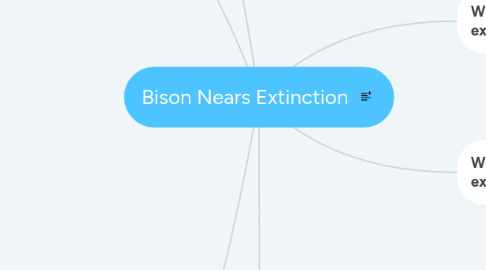
1. How the bison nearly went extinct
2. Effects of the bison's disappearance on the ecosystems
2.1. Where it had lived
2.1.1. Keystone Species
2.1.1.1. wallos promoted growth around them
2.1.1.2. soil fertility
2.1.1.2.1. pee fertilized the soil and promoted growth
2.1.1.2.2. ate where vegitation was abundent
2.1.1.2.3. self reinforcing cycle
2.1.1.2.4. urine and poop store nutrient that would have been washed away
2.1.1.2.5. trample mature vegetation that stimulates growth
2.1.1.2.6. soil fertility normal declines at 800 m/y rainfall but when there are large mammals it peaks around 900 to 1100 mm/y rainfall
2.2. Two Main Predators
2.2.1. Wolves
2.2.1.1. 1880
2.2.1.1.1. 7,000 wolf skins sold in US
2.2.1.2. 1885
2.2.1.2.1. 273 wolf skins sold in US
2.2.1.3. 1965
2.2.1.3.1. 500 wolves remained
2.2.2. Indians
2.2.2.1. reason why they permitted distruction
2.2.2.2. 1884
2.2.2.2.1. demise of buffalo
2.2.2.3. 1890
2.2.2.3.1. Wounded Knee Massacre
2.2.2.4. helped ended autonomy
3. Time Line, Population Numbers, and Geographic Areas
3.1. Half a million years ago
3.1.1. first to appear below the ice sheets
3.2. 13,000 years ago
3.2.1. dominated ungulate communities
3.2.2. around when the humans crossed over
3.2.3. two significant predators
3.2.3.1. 200,000-400,000 Plains Indians
3.2.3.2. 4000,000 wolves
3.3. 1492
3.3.1. millions roaming were key
3.3.1.1. vegetational diversity
3.3.1.2. benefit lesser ungulates
3.3.1.2.1. american entelope (9 million)
3.3.1.2.2. elk (2 million)
3.3.1.2.3. deer (3.6 million)
3.3.1.2.4. bighorn sheep (2 million)
3.3.1.2.5. and other species
3.4. 1530
3.4.1. first European to see buffalo in natural habitat
3.4.1.1. Cabeza de Vaca
3.4.1.2. SPanish explorer
3.4.1.3. southern texas
3.5. 1542
3.5.1. Francisco Coronado saw buffalo
3.5.1.1. "crookebacked oxen"
3.5.2. texas panhandle was full of them
3.6. Early 19th Century
3.6.1. Buffalo population ranged from 30 to 60 million
3.6.1.1. only accounted en masse
3.7. 1795
3.7.1. 7,360 buffalo drowned along Canadian Qu'Appelle
3.8. 1830-1868
3.8.1. most wasteful slaughter stage of buffalo
3.9. 1871-1874
3.9.1. little else was done from Doge City, Wichita, and Leavenworth area besides killing buffalo
3.9.2. 1871 - chemist perfected buffalo tanning hide process
3.9.3. each hide sent, five went to waste
3.9.3.1. some shot and allowed to wonder off to die
3.9.3.2. skinned inexpertly they had to be trashed
3.9.3.3. curers so ignorant that half obtained rotted
3.9.4. 1874
3.9.4.1. Dixon could hear buffalos calling 16 km away
3.9.4.2. thousands and thousands of buffalo as the eye could see
3.10. 1884
3.10.1. Buffalo lost the battle for the Plains
3.10.1.1. 1883 - 40,000 hides shipped east
3.10.1.2. 1884 - 300 hides shipped east
4. Why the bison nearly went extinct
5. When the bison nearly went extinct
5.1. 1884
5.1.1. Buffalo lost
6. Social attitudes that led to this wasteful human behavior
6.1. Manifest Destiny
6.1.1. "a sense that God and fate had destined them to inherit the New World in its entirety"
6.1.2. fostered by ecological and social release
6.1.3. fostered by the rich soil and thus vast bounty
6.2. changes in processing would lead to mass production
6.2.1. assembly line
6.2.2. interchangeable parts
6.2.3. mass production equals mass exploitation of resources
6.3. 1869 - First Transcontinental Railroad was completed
6.3.1. land converted to quarry and farm
6.3.2. iron web made a land boom wagonload dream
6.4. Wave of Immigration into America
6.4.1. 1500 - over 50 million Europeans, Africans and other flooded in
6.4.2. late 18th century
6.4.2.1. non slaves went north
6.4.2.2. slaves went to the south
6.4.3. demands of mass production
6.4.4. population north of Mexico swelled to about 300 million
6.5. Mass production and agriculture
6.5.1. Plains produces two thirds of world's wheat
6.5.1.1. "these activities unleashed a monster that would drink many of her rivers dry, consume her plains, blight her deserts and sterilise her seas"
